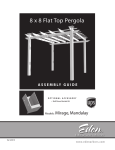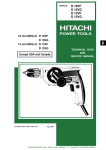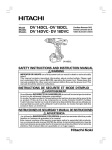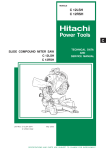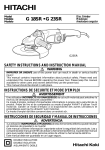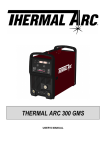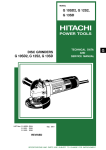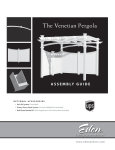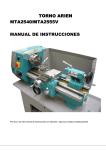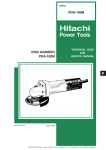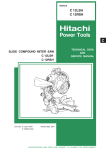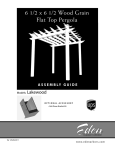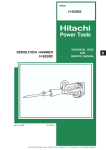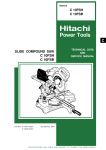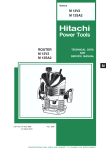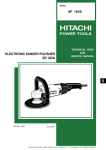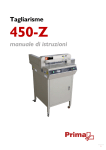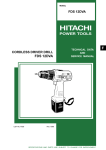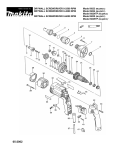Download VB 13Y
Transcript
MODEL VB 13Y POWER TOOLS PORTABLE REBAR CUTTER/BENDER VB 13Y TECHNICAL DATA AND SERVICE MANUAL V LIST No. 0782 Jan. 2000 SPECIFICATIONS AND PARTS ARE SUBJECT TO CHANGE FOR IMPROVEMENT REMARK: Throughout this TECHNICAL DATA AND SERVICE MANUAL, a symbol(s) is(are) used in the place of company name(s) and model name(s) of our competitor(s). The symbol(s) utilized here is(are) as follows: Competitors Symbols Utilized Company Name Model Name S MCC CB-13 Y ALBA DR-12E Notice for use Specifications and parts are subject to change for improvement. Refer to Hitachi Power Tool Technical News for further information. CONTENTS [ Business Section ] 1. PRODUCT NAME Page • • • • • • • • • • • • • • • • • • • • • • • • • • • • • • • • • • • • • • • • • • • • • • • • • • • • • • • • • • • • • • • • • • • • • • • • • • • • • • • • • • • • • • • • • • • • • • • • • • • • • • • • • • • • • • • • • • • • • • • • 2. MARKETING OBJECTIVE • • • • • • • • • • • • • • • • • • • • • • • • • • • • • • • • • • • • • • • • • • • • • • • • • • • • • • • • • • • • • • • • • • • • • • • • • • • • • • • • • • • • • • • • • • • • • • • • • • • • • • • • • • • 1 • • • • • • • • • • • • • • • • • • • • • • • • • • • • • • • • • • • • • • • • • • • • • • • • • • • • • • • • • • • • • • • • • • • • • • • • • • • • • • • • • • • • • • • • • • • • • • • • • • • • • • • • • • • • • • • • • • • • • • • • • • • 1 • • • • • • • • • • • • • • • • • • • • • • • • • • • • • • • • • • • • • • • • • • • • • • • • • • • • • • • • • • • • • • • • • • • • • • • • • • • • • • • • • • • • • • • • • • • • • • • • • • • • • • • • • • • • • • • • • • • • • • • • • • • • • • •• • 1 3. APPLICATIONS 4. CAPACITY 1 5. SELLING POINTS • • • • • • • • • • • • • • • • • • • • • • • • • • • • • • • • • • • • • • • • • • • • • • • • • • • • • • • • • • • • • • • • • • • • • • • • • • • • • • • • • • • • • • • • • • • • • • • • • • • • • • • • • • • • • • • • • • • • • • • 5-1. Selling Point Descriptions 6. SPECIFICATIONS • • • • • • • • • • • • • • • • • • • • • • • • • • • • • • • • • • • • • • • • • • • • • • • • • • • • • • • • • • • • • • • • • • • • • • • • • • • • • • • • • • • • • • • • • • • • • • • • • • • • • • • 2 • • • • • • • • • • • • • • • • • • • • • • • • • • • • • • • • • • • • • • • • • • • • • • • • • • • • • • • • • • • • • • • • • • • • • • • • • • • • • • • • • • • • • • • • • • • • • • • • • • • • • • • • • • • • • • • • • • • • • • • 4 7. COMPARISONS WITH SIMILAR PRODUCTS 7-1. Working Efficiency Comparison 8. HOW TO USE THIS UNIT • • • • • • • • • • • • • • • • • • • • • • • • • • • • • • • • • • • • • • • • • • • • • • • • • • • • • • • • • • • • • • • • • • • • • • • • • • • • 5 • • • • • • • • • • • • • • • • • • • • • • • • • • • • • • • • • • • • • • • • • • • • • • • • • • • • • • • • • • • • • • • • • • • • • • • • • • • • • • • • • • • • • • • • • • • • • • 5 • • • • • • • • • • • • • • • • • • • • • • • • • • • • • • • • • • • • • • • • • • • • • • • • • • • • • • • • • • • • • • • • • • • • • • • • • • • • • • • • • • • • • • • • • • • • • • • • • • • • • • • • • • • 6 9. SERVICE LIFE OF CUTTER ••••••••••••••••••••••••••••••••••••••••••••••••••••••••••••••••••••••••••••••••••••••••••••••••••••••• 10. PRECAUTIONS IN SALES PROMOTION 7 • • • • • • • • • • • • • • • • • • • • • • • • • • • • • • • • • • • • • • • • • • • • • • • • • • • • • • • • • • • • • • • • • • • • • • • • • • • • • • • • • 7 • • • • • • • • • • • • • • • • • • • • • • • • • • • • • • • • • • • • • • • • • • • • • • • • • • • • • • • • • • • • • • • • • • • • • • • • • • • • • • • • • • • • • • • • • • • • • • • • • • • • • • • • • • • • 7 ••••••••••••••••••••••••••••••••••••••••••••••••••••••••••••••••••••••••••••••••••••••••••••••••••••••••••••••••••••••• 7 10-1. Handling Instructions 10-2. Caution Plate 1 11. SAFETY INSTRUCTIONS ••••••••••••••••••••••••••••••••••••••••••••••••••••••••••••••••••••••••••••••••••••••••••••••••••••••••• 11-1. Pictograph Illustration and Explanation • • • • • • • • • • • • • • • • • • • • • • • • • • • • • • • • • • • • • • • • • • • • • • • • • • • • • • • • • • • • • • • • • • • • • • • • • • • • • • • • • • 8 9 [ Service Section ] 12. PRECAUTIONS IN DISASSEMBLY AND REASSEMBLY • • • • • • • • • • • • • • • • • • • • • • • • • • • • • • • • • • • • • • • • • • • • • • • • • • • • • • • • 10 12-1. Disassembly • • • • • • • • • • • • • • • • • • • • • • • • • • • • • • • • • • • • • • • • • • • • • • • • • • • • • • • • • • • • • • • • • • • • • • • • • • • • • • • • • • • • • • • • • • • • • • • • • • • • • • • • • • • • • • • • • • • • • • • 10 12-2. Reassembly • • • • • • • • • • • • • • • • • • • • • • • • • • • • • • • • • • • • • • • • • • • • • • • • • • • • • • • • • • • • • • • • • • • • • • • • • • • • • • • • • • • • • • • • • • • • • • • • • • • • • • • • • • • • • • • • • • • • • • • • 15 12-3. Wiring Diagram ••••••••••••••••••••••••••••••••••••••••••••••••••••••••••••••••••••••••••••••••••••••••••••••••••••••••••••••••••••• 12-4. Confirmation after Reassembly 16 • • • • • • • • • • • • • • • • • • • • • • • • • • • • • • • • • • • • • • • • • • • • • • • • • • • • • • • • • • • • • • • • • • • • • • • • • • • • • • • • • • • • • • • • • • • • • 17 12-5. Repair Procedure • • • • • • • • • • • • • • • • • • • • • • • • • • • • • • • • • • • • • • • • • • • • • • • • • • • • • • • • • • • • • • • • • • • • • • • • • • • • • • • • • • • • • • • • • • • • • • • • • • • • • • • • • • • • • • • • • 19 12-6. Tightening Torque • • • • • • • • • • • • • • • • • • • • • • • • • • • • • • • • • • • • • • • • • • • • • • • • • • • • • • • • • • • • • • • • • • • • • • • • • • • • • • • • • • • • • • • • • • • • • • • • • • • • • • • • • • • • • • • • • 20 12-7. Insulation Tests • • • • • • • • • • • • • • • • • • • • • • • • • • • • • • • • • • • • • • • • • • • • • • • • • • • • • • • • • • • • • • • • • • • • • • • • • • • • • • • • • • • • • • • • • • • • • • • • • • • • • • • • • • • • • • • • • • • • 12-8. No-load Current Value • • • • • • • • • • • • • • • • • • • • • • • • • • • • • • • • • • • • • • • • • • • • • • • • • • • • • • • • • • • • • • • • • • • • • • • • • • • • • • • • • • • • • • • • • • • • • • • • • • • • • • • • • • 13. STANDARD REPAIR TIME (UNIT) SCHEDULES • • • • • • • • • • • • • • • • • • • • • • • • • • • • • • • • • • • • • • • • • • • • • • • • • • • • • • • • • • • • • • • • • • • • • 20 20 21 [ Appendix ] Assembly Diagram for VB 13Y •••••••••••••••••••••••••••••••••••••••••••••••••••••••••••••••••••••••••••••••••••••••••••••••••••••• 22 1. PRODUCT NAME Hitachi Portable Rebar Cutter/Bender, Model VB 13Y 2. MARKETING OBJECTIVE A compact and lightweight power tool that reduces worker fatigue and enhances work efficiency. 3. APPLICATIONS Cutting and bending of rebars (concrete reinforcing rod) during construction of foundations and external structures. Cutting and bending of rebars for fitting building parts during construction of reinforced concrete buildings. 4. CAPACITY Reinforcing bar diameter: 13 mm (1/2") or less 5. SELLING POINTS Lightweight, compact and therefore easy to carry to the work site Motorized for reduced effort Hole for bolting to a fixed base Built-in microprocessor Uniform bending angles over a wider range of speeds, from low to high Variable-speed switch (1) Hand-adjustable bending (with a manual-like feel) (2) Operable at slower speeds, enabling anyone to operate it more easily Double-insulated structure --- 1 --- Reaction receiver Both cutting and bending possible with one unit 5-1. Selling Point Descriptions 5-1-1. Motorized for reduced effort A manual cutter/bender requires the worker to overcome a load of 392 to 490 N (40 to 50 kgf) to bend or cut a rebar of 13 mm (1/2") diameter. The Model VB 13 Y can reduce worker fatigue because it is motorized. Manual cutter/bender Load Fig. 1 5-1-2. Both cutting and bending possible with one unit Both a cutter and a bender are required if each tool has only a single function (cutting or bending). The Model VB 13Y can perform both cutting and bending with one unit in the same manner as a manual cutter/bender. Rebar Rebar Cutter Variable-speed switch Bending roller Fig. 2 Cutting Fig. 3 Bending 5-1-3. Lightweight, compact and therefore easy to carry to the work site The reason why manual cutter/benders have achieved widespread use in construction sites is that they are compact and lightweight. The Model VB 13Y is attractively convenient for carrying to work sites because the weight is almost the same as a manual cutter/bender (12.0 kg (26.5 lbs.)) while the size is smaller. 5-1-4. Excellent cost/performance ratio The Model VB 13Y is about two-thirds or half the price of ordinary electric cutters or benders which have only single functions while the Model VB 13Y can perform both cutting and bending (13 mm (1/2") dia. rebar) with one unit. If comparisons are made with another maker's electro-hydraulic cutter/benders (capacity rebar dia. 16 mm (5/8")), the Model VB 13Y is half the price of the electro-hydraulic cutter/bender and the cost/performance ratio is excellent. This is because the Model VB 13Y is equipped with a gear and a cam instead of a hydraulic system for cutting rebars, and an advanced microprocessor instead of an electromagnetic clutch for bending rebars. --- 2 --- 5-1-5. Variable-speed switch A manual cutter/bender has an advantage of hand-adjustable bending by eye measurement. Since the Model VB 13Y uses a variable-speed switch, rebars can also be bent to the desired angles by eye measurement with a manual-like feel while the conventional electric bender provides only a fixed-speed bending. The operator can easily vary the bending speed depending on how far the switch trigger is depressed. These features make the Model VB 13Y convenient for bending work at construction sites. 5-1-6. Built-in microprocessor The Model VB 13Y is equipped with a microprocessor for uniform bending angles over a wider range of speeds from low to high. Rebars can be bent according to the angles selected with the setting dial even if the bending speed is varied. The Model VB 13Y provides uniform bending results regardless of speeds and the motor's inertial force. 5-1-7. Double-insulated structure The Model VB 13Y has double-insulated structure for safety in use outdoors or below the ground. 5-1-8. Reaction receiver There is a need to prevent movement of the unit caused by cutting 5 m (197")-long rebars generally used in construction sites. The Model VB 13Y has two reaction receivers at the front and the rear for stable operation. 5-1-9. Hole for bolting to a fixed base A hole is provided at the center of the unit to fix and stabilize it. This hole comes in quite handy for bending operations because it allows the unit to be bolted to a suitable work bench (bolt size M10, less than W3/8). 5-1-10. Low height The Model VB 13Y has a unique design, with the bending unit being lower than the motor unit, to give the bender added stability when bending long rebars. Although the maximum capacity rebar diameter is smaller than another maker's electric cutter/bender, the Model VB 13Y is convenient to use thanks to its lower height (135 mm (5-5/ 16")) while the other maker's electric cutter/bender is 245 mm (9-41/64") high. 5-1-11. Center plate with marking for bending position adjustment The Model VB 13Y eliminates manual marking work required for bending rebars with a manual cutter/bender Center plate Marked lines because the center plate has reference markings for Rebar easy bending position adjustment. Bending roller Fig. 4 --- 3 --- 6. SPECIFICATIONS VB 13Y Model (1) Material; Rebar: Yield strength 460N/mm2 (47 kgf/mm2) max. Capacities GRADE 460 (Great Britain) BST 500 (Germany) B 500 (Spain) GRADE 40 (U.S.A.) or equivalent grades (2) Diameter of material: 8 --- 13 mm (3/8" --- 1/2")) Cutting Number of piece that can be processed at one time Bending 10 mm (3/8") max. • • • • • 1 piece 10 mm (3/8") max. • • • • • 2 pieces 13 mm (1/2") max. • • • • • 1 piece 13 mm (1/2") max. • • • • • 1 piece Motor type AC single-phase series commutator motor Enclosure Materials: Aluminum alloy die cast Glass-fiber reinforced resin (Housing, handle, tail cover) Painting: Silver, light green, black Insulation structure Double insulation Switch Speed control switch Power source Single-phase AC 50 Hz Voltage and current 1.3 A (230 V) Power input 285 W Rotation speed 0 --- 16 /min. Weight Net Product: 12.0 kg (26.5 lbs.); excluding cord Gross Packed: 13.1 kg (28.9 lbs.) Packaging Cord Corrugated cardboard box Type Two core cabtire cable Overall length 2.5 m (8.2 ft.) Standard accessories Allen key (for M5 hexagon socket bolt) One set of cutters • • • • • • • • • • • • • • • • • • • • • • • • • • • • • • • • • • • • • 1 pc. • • • • • • • • • • • • • • • • • • • • • • • • • • • • • • • • • • • • • • • • • • • • • • • • • • • • • • • • • • • • • • • • • • • • 1 set. --- 4 --- 7. COMPARISONS WITH SIMILAR PRODUCTS Specification Comparisons Maker HITACHI Model name VB13Y S Y Power Input W 285 Power Output W 300 /min 16 Length mm 430 (16-15/16") 1,050 (41-3/8") 950 (37-7/16") Height mm 196 (7-3/4") 115 (4-17/32") 250 (9-27/32") Width mm 197 (7-3/4") 220 (8-21/32") 135 (5-5/16") 11.5 (25.4 Ibs.) 12.3 (27.1 Ibs.) S Y 13 (1/2") 13 (1/2") 13 (1/2") Motorized gear drive system Manual Manual Rotation Speed Dimensions Double Insulation Insulation Structure Full-load vibration level dB (VL) 91.4 No-load Noise Level dB (A) 79 kg 12.0 (26.5 Ibs.) Weight (excluding cord) 7-1. Working Efficiency Comparison Maker HITACHI Model name VB 13Y Capacity Rebar Dia. mm Drive System Cutting Time seconds/operation 3.2 *10 Bending Time (180˚) seconds/operation 4 *15 13 * The data shown in the above table are mean values of 50 bending operations. (The cutting time and bending time may vary in accordance with operating conditions such as the load to be applied.) The cutter/bender sketched below is also used in Europe. Manual cutter/bender Load Load Fig. 5 Fig. 6 --- 5 --- 8. HOW TO USE THIS UNIT (1) Cutting work (Fig. 7) Rebar Cutter Variable-speed switch Fig. 7 Alignment marks Setting dial (2) Bending work (Fig. 8) Rebar To switch between cutting and bending To adjust bending angle (0 fl --- 180 fl) Fig. 7, 8-a Fig. 8 Bending roller Variable-speed switch --- 6 --- 9. SERVICE LIFE OF CUTTER The life of a cutter edge is rated at 2,500 operations. (5,000 operations using both edges of each cutter blade). When the edge of a cutter is worn out or deformed, turn the cutter around so that the other edge is properly set or replace the cutter with new one. 10. PRECAUTIONS IN SALES PROMOTION In the interest of promoting the safest and most efficient use of the Model VB 13Y Portable Rebar Cutter/Bender by all of our customers, it is very important that at the time of sale the salesperson carefully ensures that the buyer seriously recognizes the importance of the contents of the Handling Instructions, and fully understands the meaning of the precautions listed on the Caution Plate attached to each tool. 10-1. Handling Instructions Salespersons must be thoroughly familiar with the contents of the Handling Instructions in order to give pertinent advice to the customer. In particular, they must have a thorough understanding of the precautions for use of the portable rebar cutter/bender which is different from those of ordinary electric power tools. 10-2. Caution Plate Each Model VB 13Y unit is provided with a Caution Plate (illustrated below) which lists basic safety precautions in its use. Carefully ensure that the customer fully understands and follows these precautions before using the tool. For Europe and the other --- 7 --- 11. SAFETY INSTRUCTIONS Be particularly careful to ensure that the customer understands the following precautions which are listed on the Handling Instructions and Caution Plates attached to the main body of each tool. (1) Do not cut and/or bend any materials other than rebar. Avoid any work exceeding the maximum capacities of the unit described in the specifications. Otherwise, the cutter can be damaged and the material can shatter into pieces. (2) While turning the switch on, never put your hand close to the cutter. For the sake of safe operation, the Model VB 13Y is designed as follows: Cutter cover is provided. Gear cover prevents finger access to the cutter. Bending unit has no opening. Bending unit is designed so that fingers cannot be inserted. Although these safety measures are taken, the opening of the cutter must be exposed for workability. Unintentional starting with fingers touching the cutter can cause serious injury. Never bring your hand close to the cutter while the plug is connected to a receptacle. (3) Make absolutely sure that the cutter cover is closed when you are not carrying out cutting work. If the cover is kept open, the cutter can jam on foreign objects and cause serious accidents. (4) Reserve an extra length of at least 120 mm (4 --- 23/32") Extra length on the bending length of the rebar to be bent (Fig. 9). If the extra length is not long enough, the rebar can come 120 mm (4 --- 23/32") or more off during the bending operation, or it can break into fragments Fig. 9 and scatter dangerously. (5) Begin operation only after making sure that there are no people or objects within the turning range of the material to be bent. (6) If the switch is turned off and then immediately turned on again, the motor may not start, as a safety precaution. Wait for at least one full second before attempting to turn the motor on again after it has been switched off. (7) Note that the unit is not a hand-held tool. Be absolutely sure to use the unit only after placing it on a stable surface such as a floor, the ground, etc. (8) Be sure to unplug the power cord from the receptacle when the cutter is being checked, cleaned, or parts replaced. Failure to do so can result in a serious injury. --- 8 --- 11-1. Pictograph Illustration and Explanation Do not use or leave this electric power tool in wet weather Read handling instructions before use. conditions. Begin operation only after making sure that there are no people within the turning range of the material to be bent. Never bring your hand close to the cutter during operation. If the switch is turned off and then immediately turned on again, the motor may not start. Wait for at least one full second before attempting to turn the motor on again after it has been switched off. Do not attempt to cut two rebars at one time. Avoid any work exceeding the maximum capacities. (Rebar diameter 13 mm (1/2") ) --- 9 --- 12. PRECAUTIONS IN DISASSEMBLY AND REASSEMBLY The [Bold] numbers in the descriptions below correspond to the item numbers in the Parts List and exploded assembly diagram. 12-1. Disassembly (1) Disassembly of the handle (Fig. 10) Remove the two Tapping Screws (W/Flange) D4 x 20 [81] and the Tail Cover [82]. Remove the two Tapping Screws (W/Flange) D5 x 20 [104], four Tapping Screws D4 x 20 (W/Flange) [81] and two Machine Screws (W/Washers) M5 x 20 [105] to remove the Handle (A).(B) Set [94]. [82] [81] [98] [86] [95] [88] [94] [13] [81] [104] [105] Cable Rubber [22] connector bushing Cable Fig. 10 (2) Removal of the cable (Fig. 11) Disconnect the connector by pulling the rubber bushing and the cable in the direction of the arrow. *1. Gently pull the cable by moving it from side to side to disconnect the connector. *2. If the one part of the connector remains in the gear cover due to yanking the cable, disassemble the gear cover referring to "(5) Disassembly of the gear" and remove the remaining connector from the gear cover. Connector Cable Rubber bushing Gear cover Fig. 11 --- 10 --- (3) Disassembly of the power supply unit 1) Removal of the Controller Circuit [95] (Fig. 10) Remove the rubber bushing and pull out the cable of the Controller Circuit [95] from the Gear Cover Ass'y [22]. Disconnect the cable connector from the cable and separate the Controller Circuit [95] from the Gear Cover Ass'y [22]. (The cable connector can be disconnected by pulling it out with hands.) Disconnect the Connector [98] which connects the seven internal wires with the Stator Ass'y [88]. 2) Disassembly of the housing Remove the Brush Cap [76] and take out the Carbon Brush [77]. Remove the four Hex. Socket Hd. Bolts (W/Flange) M5 x 30 [79] from the Housing Ass'y [86]. The Housing Ass'y [86] can then be removed from the Inner Cover Ass'y [13]. (4) Disassembly of the bending unit (Fig. 12) 1) Remove the Hex. Socket Hd. Bolt M5 x 12 [1], Hex. Socket Hd. Bolt (W/Flange) M5 x 16 [29] and the Center Plate (A) [3]. 2) Remove the Hex. Socket Hd. Bolt M5 x 12 [1] and the Roller (B) [30]. 3) Remove the Lever (A) [31], Turn Table [5] and the five Flat Hd. Screws M4 x 10 [32] to remove the Cam Cover [6]. [31] [1] [29] [3] [32] [6] [5] [1] Fig. 12 --- 11 --- [30] (5) Disassembly of the gear (Figs. 13, 14 and 15) 1) Remove the two Hex. Socket Hd. Bolts (W/Flange) M4 x 10 [58] from the bottom of the Gear Cover Ass'y [22] and remove the Sensor Cover [28] and the O-Ring (S-85) [27]. 2) Mark the engagement point between the Sensor Gear [26] and the Sensor Gear [56] with a magic marker as shown in Fig. 13-b. Then, remove the Seal Lock Screw (W/SP. Washer) M4 x 12 [36] and Washer (B) [57] to remove the Sensor Gear [56] (Fig. 13). [58] Mark the engagement point before disassembly. [28] Projection [36] [56] [29] Fig. 13-b Disassembly [57] [23] [24] Fig. 13-a [26] The number of teeth between the point B and the projection should be the same. B (Engagement point) * Marking should be made for easy reassembly. Otherwise, Adjust the position of the protrusions by turning the gear. adjust the sensor gears so that the number of teeth between the engagement point and the projection is the same each Fig. 13-c Reassembly other as shown in Fig. 13-c and then mount them. Fig. 13 3) Remove the seven Hex. Socket Hd. Bolts (W/Flange) M5 x 16 [29] and the Gear Cover Ass'y [22]. Then First Pinion (B) [55], Second Pinion [47] and Third Pinion [43] can be removed. The Final Gear [18] can be removed by removing the Retaining Ring for D25 Shaft [19]. If it is hard to remove the Final Gear [18], use a bearing puller for removal. The Cam Shaft [12] can be removed just by pulling upward (toward Cam Cover [6]) if the Final Gear [18] has already been removed. [29] [28] [22] [56] [36] [57] [27] Not removable [58] Fig. 14 --- 12 --- [18] [19] [12] Third Pinion Second Pinion First Pinion (B) Fig. 15 (6) Disassembly of the gear unit (Figs. 16, 17 and 18) 1) Press First Pinion (B) [55] in A direction with a hand press supporting the surfaces B and C respectively. Then remove Sleeve (B) [50], First Gear (B) [51], Clutch Spring [52], Collar (A) [53] and Washer [54] (Fig. 16). 2) Remove the Second Pinion [47] from the Second Gear [48] by pressing with a hand press (Fig. 17). 3) Remove the Feather Key [44] and the Third Pinion [43] from the Third Gear [45] by pressing with a hand press (Fig. 18). A [52] [50] [47] [51] [43] [44] Press-fitted B surface [54] C surface [48] Press-fitted [53] [45] [55] Fig. 16 Fig. 17 Fig. 18 (7) Removal of bracket (A), bracket (B) and covers (Figs. 19 and 20) 1) Remove the Seal Lock Screw (W/SP. Washer) M4 x 12 [36] and Thrust Washer [37] that fix the Return Spring [38] from the upper surface of the Inner Cover Ass'y [13]. Then remove the Return Spring [38] from the Inner Cover [13] (by prying it off with a flat-blade screwdriver). 2) Remove the two Hex. Socket Hd. Bolts M5 x 16 [67] and the Flange Nut M12 [39] from the inside of the Inner Cover Ass'y [13]. Then remove Bracket (A) [68], Bracket (B) [73], Cover [63] and O-Ring (S-34) [64] from the Inner Cover [13]. --- 13 --- [13] [38] [63] Hook [64] [36] [13] [68] [73] [37] [34] [39] [67] [66] [65] [67] Fig. 19 Fig. 20 (8) Disassembly of bracket (A) and (B) unit (Fig. 20) Press the Bolt (A) [65] with a hand press supporting Bracket (A) [68]. Then the Feather Key [66], Bracket (A) [68] and Bracket (B) [73] can be removed. (9) Disassembly of bracket (A) unit (Fig. 21) 1) Remove the Retaining Ring for D9 Shaft [61]. Then the Pin for Spring [72], Spring (C) [71] and Cutter Guard [70] can be removed. 2) Pull out the Needle [60] with a hand press to remove Roller (C) [62] from Bracket (A) [68]. [72] [71] [62] [70] [61] [68] [60] Fig. 21 (10) Disassembly of the cam shaft unit (Fig. 22) Remove the Cam [8] and two Feather Keys [34] from the Cam Shaft [12] with a hand press. --- 14 --- 12-2. Reassembly Reassembly can generally be carried out as the reverse of the disassembly procedure, with some items to be noted as follows. (1) Reassembly of the cam shaft unit (Fig. 22) Perform reassembly so that the chamfered portion of the [34] Pin Cam Shaft [12] is aligned with the pins of the Cam [8] in the same direction. [8] * Otherwise, the Sensor Gear [56] cannot be mounted in Same direction the proper position and damage to the volume and the gear will result. Be sure to check the mounting direction [12] after reassembly. Chamfered portion (2) Reassembly of bracket (A) unit (Fig. 23) Mount Bracket (A) [68] to Spring (C) [71] so that the Fig. 22 folded portion of Spring (C) [71] securely fits in the notch of the Cutter Guard [70] (Fig. 23). Apply grease (TUFREX 251) to the hole of Roller (C) [62] adequately [70] [68] [72] (Fig. 24). [71] (3) Reassembly of bracket (A) and (B) unit (Fig. 24) Mount the Bolt (A) [65] to Bracket (A) [68]. Apply grease [62] (TUFREX 251) to the shaded areas shown in Fig. 24 adequately. Mount the Feather Key [66] to Bracket (A) Folded portion [68] and press-fit it to Bracket (B) [73]. Fig. 23 (4) Installation of bracket (A) and (B) unit to the inner cover (Figs. 19 and 20) Mount bracket (A) and (B) unit into the Inner Cover Ass'y [13] and secure it with two Hex. Socket Hd. Bolts M5 x 16 [67] and the Flange Nut M12 [39]. Hook one end of the [65] [60] [61] [66] [68] [62] Return Spring [38] in the groove of the Pin for Spring [72] and the other end on the projection of the Inner Cover Ass'y [13]. Secure it with the Thrust Washer [37] and the [70] Apply grease. [69] [71] [72] Seal Lock Screw (W/SP. Washer) M4 x 12 [36]. [69] * For easy reassembly, mount the Return Spring [38] first [73] before mounting the Cam Shaft [12]. Use a flat-blade [67] screwdriver for mounting the Return Spring [38]. Fig. 24 --- 15 --- [67] (5) Reassembly of bending unit (Figs. 12 and 22) Mount the Cam Cover [6], Turn Table [5] and Center Plate (A) [3] in the reverse of the disassembly procedure. Before mounting the Center Plate (A) [3], apply grease (TUFREX 251) to the 18 mm dia. hole of Center Plate (A) [3] adequately. Check that the hole of the Turn Table [5] and the pin of the Cam [8] are properly adjusted to ensure smooth movement of Roller (B) [30]. (6) Installation of gears Apply grease (Nippeko SEP-3A) to the meshing parts of First Pinion (B) [55], Second Pinion [47], Third Pinion [43] and Final Gear [18], and mount them in the reverse of the disassembly procedure. Apply grease (TUFREX 251) to the Clutch Spring [52], Collar (A) [53] and the boss of First Gear (B) [51] adequately. Check that the Sensor Holder Ass'y [23] is mounted and the wiring is completed. Secure the Inner Cover Ass'y [13] and the Gear Cover Ass'y [22] with seven Hex. Socket Hd. Bolts (W/Flange) M5 x 16 [29]. * Perform wiring of the Sensor Holder Ass'y [23] in this step. Wiring in later step is impossible though the Sensor Holder Ass'y [23] is secured with the Tapping Screw D3 x 12 [24] in the next step (Fig. 13-a). (7) Installation of the Sensor Gear [56] (Fig. 13) Mount the Sensor Gear [56] in the reverse of the disassembly procedure shown in 12-1 (5) 2). Pay attention to the mounting position of the Sensor Gear [56]. 12-3. Wiring Diagram Be sure to perform wiring connections as indicated in the wiring diagrams. For products without noise suppressor Switch Stator Stator Cord Armature Printed Circuit Board Ass'y Control Circuit Ass'y Fig. 25 --- 16 --- For products with noise suppressor CR Unit (0.022 µF + 5 KΩ) Switch Stator Choke Coil 8 µH Cord Printed Circuit Board Ass'y Armature Choke Coil 5 µH CR Unit (0.022 µF + 5 KΩ) Stator Control Circuit Ass'y Capacitor (0.22 µF + 2 x 3300 pF) Fig. 26 12-4. Confirmation after Reassembly (1) Check the accuracy with an angle gauge (Figs. 27, 28 and 29). 1) Adhere an angle gauge to the Turn Table [5] (Fig. 27). 2) Turn the Volume Holder Ass'y [100] (bending angle selector) clockwise until it is locked (Fig. 28). 3) Pull the trigger slightly to run the machine as slow as possible. 4) It is all right if the Turn Table [5] starts backward rotation from the marked line for 13 mm dia. bar with the marking on the angle gauge aligned (Fig. 29). 5) If the marking on the angle gauge is not aligned with the marked line for 13 mm dia. bar, perform adjustment according to the next step (2). <Initial position> [5] Angle gauge Align with the perimeter. Fig. 27 --- 17 --- <Starting position for backward rotation> Marked line for 13 mm dia. bar Marking on the angle gauge [100] Check the starting position for backward rotation. Fig. 29 Fig. 28 (2) Adjust the bending accuracy as follows (Fig. 30). 1) Unplug the power cord from the receptacle. 2) Slightly turn the fine-adjustment control on the Controller Circuit [95] with a screwdriver. 3) Plug the power cord in the receptacle and check the accuracy again with an angle gauge. Repeat the adjustment until the marking is aligned. * Be sure to unplug the power cord from the receptacle before touching the circuits for safety's sake. <Locations of marking and marked line> <Turning direction> Marked line for 13 mm dia. bar Right Marking on the angle gauge Fine-adjustment control Small rotation angle Left Large rotation angle Fig. 30 --- 18 --- 12-5. Repair Procedure Following table shows rough repair procedures. Refer to the above mentioned disassembly and reassembly procedures for details. * Be sure to confirm the operation of the controller circuit, gears, brackets and cam after reassembly of them, and perform adjustment if necessary. No. 1 Item Replacement of control circuit Procedure 12-1 (1) Disassembly of the handle 12-1 (2) Removal of the cable Remarks Wiring of the controller circuit * Refer to "12-3. Wiring Diagram". Confirmation after reassembly * Refer to 12-4 (1) and (2). 12-1 (3) Disassembly of the power supply unit 12-2 Reassembly 12-4 Confirmation after Reassembly 2 Replacement of gears, brackets and cam 12-1 (1) Disassembly of the handle 12-1 (2) Removal of the cable 12-1 (4) Disassembly of the bending unit (Fig. 12) Removal of sensor gear Disassembly of the gear unit, bracket unit and cam unit 12-2 Reassembly 12-4 Confirmation after Reassembly --- 19 --- Removal and installation of the sensor gear * Refer to 12-1 (5) and 12-2 (6). Confirmation after reassembly * Refer to 12-4 (1) and (2). 12-6. Tightening Torque Machine Screw (W/Washers) M5 3.4 0.7 N•m (35 7 kgf•cm) (30.4 6.1 in-Ibs.) Seal Lock Screw M4 1.8 0.4 N•m (18 4 kgf•cm) (15.6 3.5 in-Ibs.) Machine Screw Machine Screw (for the Sensor Gear only) M4 1.8 0.4 N•m (18 4 kgf•cm) (15.6 3.5 in-Ibs.) 1 0.2 N•m (10 2 kgf•cm) (8.7 1.7 in-Ibs.) Flange Nut M12 39.2 Tapping Screw (W/Flange) D5 2.9 0.5 N•m (30 5 kgf•cm) (26 Tapping Screw (W/Flange) D4 2.0 0.5 N•m (20 5 kgf•cm) (17.4 4.3 in-Ibs.) Hex. Socket Hd. Bolt M5 5.9 1.5 N•m (60 15 kgf•cm) (52 13 in-Ibs.) Hex. Socket Hd. Bolt M4 3.4 0.7 N•m (35 7 kgf•cm) (30.4 6.1 in-Ibs.) 7.8 N•m (400 80 kgf•cm) (347.2 4.3 in-Ibs.) 12-7. Insulation Tests On completion of disassembly and repair, measure the insulation resistance and dielectric strength. Insulation resistance: 7 MΩ or more with DC 500 V megohm tester Dielectric strength: AC 4000 V/1 minute, with no abnormalities .... 230 V 12-8. No-load Current Value After no-load operation for 30 minutes, the no-load current value should be as follows. Voltage Current (Max.) 230 V 1.3 --- 20 --- 69.4 in-Ibs.) 13. STANDARD REPAIR TIME (UNIT) SCHEDULES MODEL Variable Fixed 10 20 30 40 50 70 min. Work Flow VB 13Y Tail Cover Handle (A).(B) Set Controller Circuit O-Ring Volume Holder Ass'y Steel Bar Switch Rubber Guide Cover Switch Cord Armor Cord Rubber Bushing Housing Ass'y Bearing Bushing (B) Ball Bearing (608VV) x 2 Stator Ass'y Fan Guide Armature General Assembly Sensor Cover Gear Cover Final Gear Ass'y Ball Bearing O-Ring (S-85) (6201VV) Sensor Gear Sensor Holder Ass'y Center Plate Roller (B) O-Ring (P-18) Turn Table Lever Cam Cover Felt Packing x2 Cover O-Ring (S-34) Dust Guard First Pinion Ball Bearing (608VV) Clutch Spring First Gear Metal Second Pinion Second Gear Ball Bearing (608VV) Metal Third Pinion Feather Key (5 x 5 x 10) Third Gear Metal (B) Ball Bearing (6301VV) --- 21 --- Cam Inner Cover Ass'y Lock Pin (B) V-Ring Cam Shaft Feather Key (7 x 7 x 15) x 2 Return Spring Bolt (A) Feather Key (4 x 4 x 8) Bracket (A) Cutter Guard Spring (C) Pin for Spring Bracket (B) Needle Roller (C) Assembly Diagram for VB 13Y --- 22 --- VB 13Y PARTS ITEM NO. 1 CODE NO. DESCRIPTION NO. USED 2 998-471 HEX. SOCKET HD. BOLT M5X12 2 316-224 WASHER 2 3 318-288 CENTER PLATE (A) 1 4 873-570 O-RING (P-18) 1 5 316-220 TURN TABLE 1 6 316-219 CAM COVER 1 7 316-216 FELT PACKING 1 8 316-199 CAM 1 9 939-540 RETAINING RING FOR D10 SHAFT (10 PCS.) 1 10 316-201 LOCK PIN (B) 1 11 316-198 V-RING 1 12 316-200 CAM SHAFT 1 13 316-184 INNER COVER ASS’Y 1 14 316-225 STAND 1 15 931-701 BEARING LOCK 1 16 316-195 HEX. SOCKET HD. BOLT (W/FLANGE) M5X20 2 17 630-1VV BALL BEARING 6301VVCMPS2L 1 18 316-202 FINAL GEAR 1 19 965-469 RETAINING RING FOR D25 SHAFT 1 REMARKS INCLUD.17,35,41,42 20 620-1VV BALL BEARING 6201VVCMPS2L 1 21 316-451 PIN D18 1 22 316-211 GEAR COVER ASS’Y 1 INCLUD.20,21,46,49 23 318-284 SENSOR HOLDER ASS’Y 1 INCLUD.24,56 24 316-214 TAPPING SCREW D3X12 1 25 949-215 MACHINE SCREW M4X8 (10 PCS.) 2 26 316-212 SENSOR GEAR 1 27 985-227 O-RING (S-85) 1 28 316-215 SENSOR COVER 1 29 994-192 HEX. SOCKET HD. BOLT (W/FLANGE) M5X16 9 30 316-223 ROLLER (B) 1 31 318-287 LEVER (A) 1 32 949-322 FLAT HD. SCREW M4X10 (10 PCS.) 5 33 316-217 FELT PACKING 1 34 306-506 FEATHER KEY 7X7X15 4 35 316-186 SUPPORT (B) 1 36 987-203 SEAL LOCK SCREW (W/SP. WASHER) M4X12 2 37 875-249 THRUST WASHER 1 38 316-197 RETURN SPRING 1 39 316-196 FLANGE NUT M12 1 40 307-607 WRENCH HOLDER 1 41 316-185 METAL 1 42 954-940 METAL D8X10 1 43 316-203 THIRD PINION 1 44 948-015 FEATHER KEY 5X5X10 1 45 316-204 THIRD GEAR 1 46 954-789 METAL (B) 1 47 316-205 SECOND PINION 1 48 316-206 SECOND GEAR 1 49 608-VVM BALL BEARING 608VVC2PS2L 2 50 318-360 SLEEVE (B) 1 51 318-358 FIRST GEAR (B) 1 PARTS * : ALTERNATIVE --- 23 --- 9 --- 99 VB 13Y PARTS ITEM NO. 52 CODE NO. 316-209 DESCRIPTION CLUTCH SPRING NO. USED 1 53 316-208 COLLAR (A) 1 54 981-077 WASHER 1 55 318-359 FIRST PINION (B) 1 56 316-212 SENSOR GEAR 1 57 962-569 WASHER (B) 1 58 316-228 HEX. SOCKET HD. BOLT (W/FLANGE) M4X10 2 59 316-226 STEEL BAR GUIDE 1 60 316-190 NEEDLE 1 61 992-805 RETAINING RING FOR D9 SHAFT 1 62 316-189 ROLLER (C) 1 63 318-285 COVER 1 64 980-879 O-RING (S-34) 1 65 316-194 BOLT (A) 1 66 980-809 FEATHER KEY 4X4X8 1 67 949-821 HEX. SOCKET HD. BOLT M5X16 (10 PCS.) 2 68 316-188 BRACKET (A) 1 69 316-235 CUTTER (1 PAIR) 2 70 316-191 CUTTER GUARD 1 71 316-192 SPRING (C) 1 72 316-193 PIN FOR SPRING 1 73 316-187 BRACKET (B) 1 74 316-222 DUST GUARD 1 75 938-477 HEX. SOCKET SET SCREW M5X8 2 76 935-829 BRUSH CAP 2 77 999-043 CARBON BRUSH (1 PAIR) 2 78 971-001 BRUSH HOLDER 2 79 313-585 HEX. SOCKET HD. BOLT (W/FLANGE) M5X30 4 80 318-286 CAUTION PLATE (E) 1 81 301-653 TAPPING SCREW (W/FLANGE) D4X20 (BLACK) 6 82 316-227 TAIL COVER 1 83 310-111 BEARING BUSHING (B) 1 84 318-362 BALL BEARING (A) 2 HITACHI LABEL 1 85 86 310-146 HOUSING ASS’Y 1 87 930-703 BRUSH TERMINAL 2 88 340-419E STATOR ASS’Y 230V 1 89 990-861 INTERNAL WIRE 1 90 980-864 HEX. HD. TAPPING SCREW D5X40 2 91 980-931 FAN GUIDE 1 92 360-470E ARMATURE 230V 1 NAME PLATE 1 94 316-234 HANDLE (A).(B) SET 1 95 318-282 CONTROLLER CIRCUIT 1 96 318-283 INTERNAL WIRE 1 97 981-373 TUBE (D) 1 98 959-140 CONNECTOR 50091 (10 PCS.) 7 99 878-609 O-RING (S-24) 1 100 318-281 VOLUME HOLDER ASS’Y 1 101 318-289 CAUTION PLATE (D) 1 93 9 --- 99 PARTS * : ALTERNATIVE --- 24 --- REMARKS INCLUD.75,78 INCLUD.87 INCLUD.99 VB 13Y PARTS ITEM NO. 102 CODE NO. 995-362 NO. USED 1 DESCRIPTION SWITCH RUBBER COVER 103 318-280 SWITCH (2P PLUG IN TYPE) W/O LOCK 1 104 302-089 TAPPING SCREW (W/FLANGE) D5X20 (BLACK) 2 105 316-229 MACHINE SCREW (W/WASHERS) M5X20 (BLACK) 2 106 981-373 TUBE (D) 1 107 984-750 TAPPING SCREW (W/FLANGE) D4X16 2 REMARKS FOR CORD 108 937-631 CORD CLIP 1 * 109 938-051 CORD ARMOR D10.1 1 * 109 953-327 CORD ARMOR D8.8 1 * 110 500-247Z CORD 1 (CORD ARMOR D8.8) * 110 500-450Z CORD 1 (CORD ARMOR D10.1) FOR GBR * 110 500-248Z CORD 1 (CORD ARMOR D10.1) FOR SUI STANDARD ACCESSORIES ITEM NO. 501 CODE NO. 944-458 NO. USED 1 DESCRIPTION HEX. BAR WRENCH 4MM * : ALTERNATIVE PARTS --- 25 --- REMARKS Printed in Japan (990920 N) 9 --- 99




























